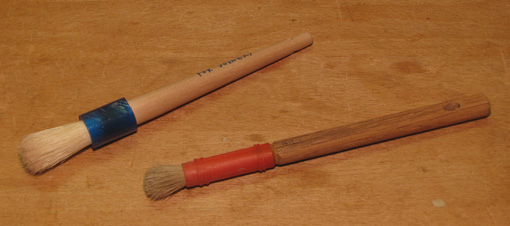Here’s a little tip that you may find helpful. I use these little brushes constantly in the shop.
The lower one in the picture, with the red collar, is labeled “oily.” I use it often to clear plane and spokeshave throats of dust and jammed shavings, especially when I need a clear look to adjust the projection of a blade. The bristles have been shortened to give them helpful stiffness. This brush gets all sorts of other duties clearing dust and chips in small tool places and spaces, including where there may be some oil hanging around. This might include bandsaw bearings, screw heads in machinery, plane and blade parts, and so forth.
When cutting joinery, I do not want to use that brush for clearing chips and dust that didn’t get blown away from tiny spaces. So, I use the other brush in the photo, labeled “for joinery.” It stays away from any oil.
I doubt this simple work habit would be found in woodworking books and articles. It’s the kind of thing that I imagine an apprentice might pick up from his teacher without it ever being mentioned. That’s one place where blogs are handy, to share this kind of tip.



I like it! I only have a “joinery” brush, which is just an old paint brush. I’ll have to add an “oily” brush. I have to admit I haven’t made much of a distinction prior to this, but I’ve always been careful not to get my joinery brush too dirty. Thanks!
Great tip Rob especially that oily brush. If nothing else it is a good rust preventative to be able to clean off the blade of a plane after using it.
Thanks for the comments, Carl and Shannon. Sometimes I wonder whether these little shop details are worth writing about, but I do think they are worth it, as your comments confirm.
Rob